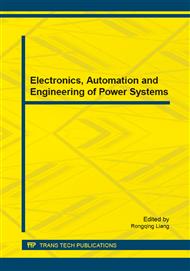p.816
p.822
p.827
p.834
p.841
p.847
p.852
p.858
p.864
Power Control of PWM Rectifier with Resistive and Reactive Load
Abstract:
The realization of power modeling and power control of PWM rectifier with resistive and reactive load is based on the method of Lyapunov. Firstly, PWM rectifier's mathematical power model is established in d-q synchronous rotating coordinates, and balance point is found according to the control requirement of the system and analysis the stability of the equilibrium point according to the Lyapunov method and invariant theory. Then PWM rectifier's power controller has been gotten through damping injection. The designed power controller realizes fast voltage tracking and makes the net side power factor as 1, which has great inhibitory effect on resistive and inductive disturbance. Influence on the system exerted by different damping injection is analyzed and feasibility of PWM rectifier's power control based on Lyapunov method is verified.
Info:
Periodical:
Pages:
841-846
Citation:
Online since:
February 2015
Authors:
Keywords:
Price:
Сopyright:
© 2015 Trans Tech Publications Ltd. All Rights Reserved
Share:
Citation:


